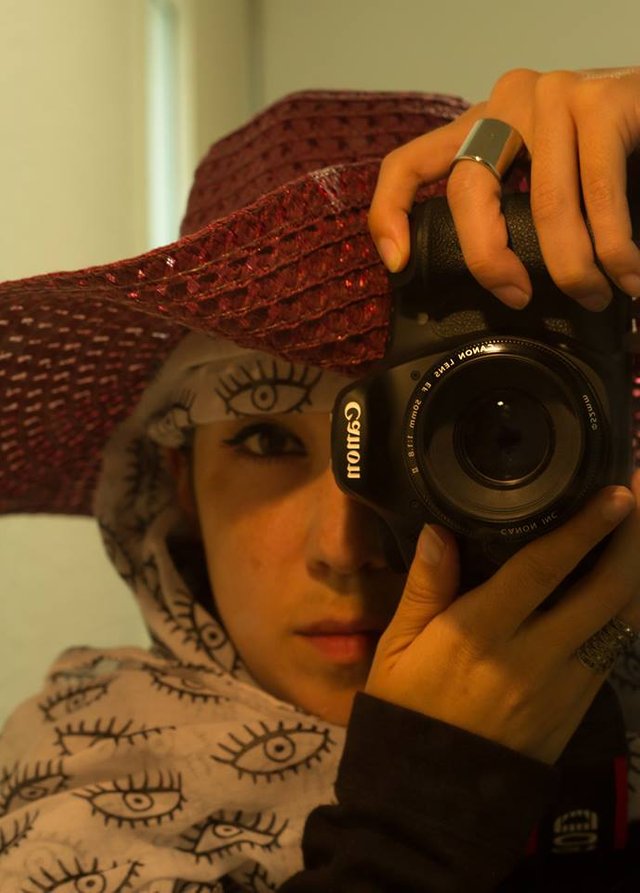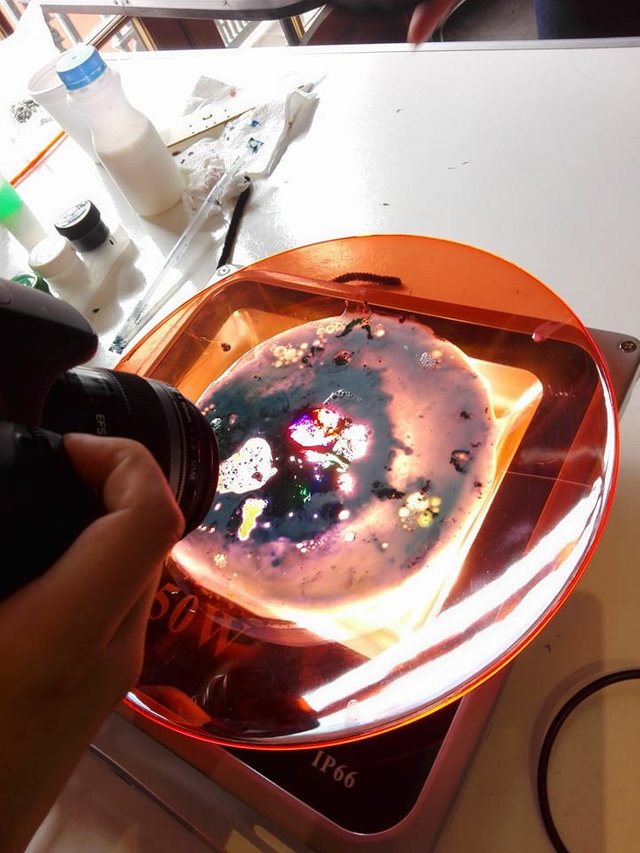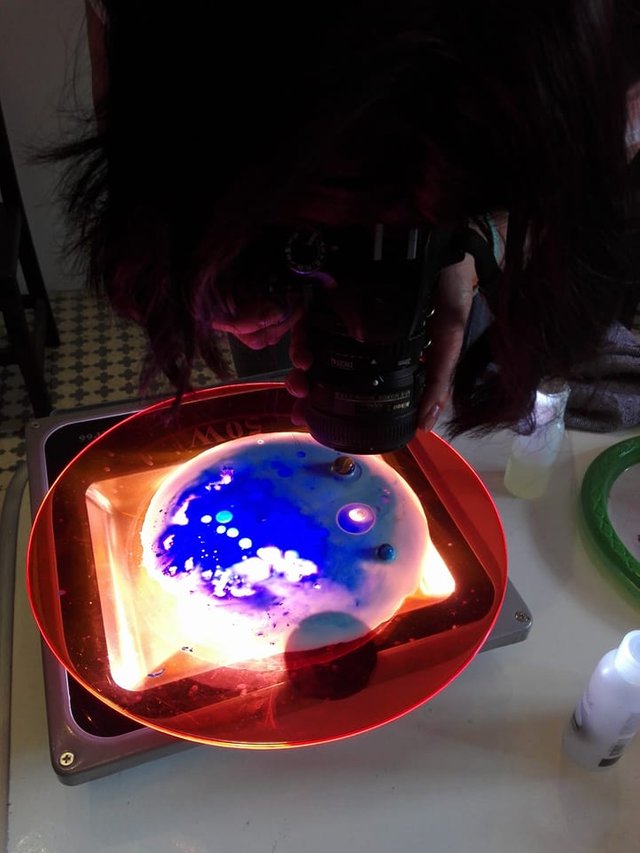Hello steemian's ! I would like to introduce myself, I am a macro photographer
Introduction
My name is keisya, I was born in 1986 in México, where I still live today. Encouraged by my parents from a young age to pursue any artistic tendency.Nothing prepared me for what lay ahead, and I had no clue that my world would turn upside down in the years to follow.

When I first got the camera, my friend came to my office one day and asked me to photograph an insect that was watching and we did. The experience was worse than terrible, due to my abilities then, but we were allowed to see the insect in much more detail than we can in normal conditions. That's why I started and so I really enjoy the macros. They let you see what you could not rdinalmente. As a scientist, I am curious by nature. I kept photographing insects, having fun and my camera was reasonably good for it. I also liked that while developing my skills photographing insects, all my other photos (dogs, family, etc.) also improved.
The Internet (web) and photo forums were my photography teacher. Therefore, I am especially grateful to those who have given me honest and constructive criticism. I think my dream is that someday my images appear in children's books or other educational materials.
I am writing this article because when I publish my images in the forums, people usually ask me how I did them. So I'll try to tell them. Keep in mind that I'm just an amateur self-taught who wants to experiment and has an insatiable curiosity. However, I hope this information will be useful and allow them to have more fun, taking and creating images.
Philosophy
Most of my insects have been photographed in their natural environment. I do not cool them, I get nails. Sometimes I move some grass or vegetation leaves to have a better view, even more infrequently, relocate them in a new location. However, they are always alive and in good condition when I photograph them.

Occasionally, the photographs in some building (especially in the whites) or some other structure constructed by the man. I like white buildings especially because I can overexpose it a bit and remove any remnants of the building in the digital darkroom, giving the image a studio type quality.
My goal when photographing insects is to present them in positive light; Show it at its best view. Especially I like intimate portraits, behavioral photos and full body photos with clear and soft backgrounds.
Equipment
- Some photos of the equipment I use are available.
- Canon Powershot G1 Digital Camera (35-103mm zoom) 3Mp
- Recently replaced by a Canon Powershot G3 (35-140mm) 4Mp
- Lensemate adapter tube to allow placement of filters in the camera
- Several close-up lenses (or diopter)
- Tiffen +10 & +7
- Hanimex +6
- Royal & Quantary Games (+3, +2, & +1 in each)
- TeleConverter Tiffen Megaplus 2x Zoom (2xTC)
- Lens Pentax 50mm F1.4 (a fast lens normal)
- Macro coupling ring (to place the lens in inverted position), some only stick two filters together.
- Canon Speedlite 420ex Flash
- Various Stofen Omnibounce diffusers
- Kirk Butterfly Bra
- Canon off-shoe cord (allows me to mount the flash on the bra)
- Tripods and a macro focus rail (or slider)
Using Close-Ups
A close-up lens allows the camera to focus closer than it normally can. This means that the image will appear larger in the frame because you can zoom in on it. In other words, the close-ups allow us to magnify the image. A diopter lens is actually a magnifying glass or magnifying glass.
The close-ups can be stacked. When this is done, the most powerful close-up should be the one closest to the camera. I have stacked it up to +27. The problem with stacking them is that the quality decreases because there is more glass and more light distortions and abnormalities occur. Another problem is that when the magnification increases, the depth of field (DOF) decreases. With really large magnifications, the DOF is reduced to the thickness of a sheet of paper.

Another important point with close-ups is that you need to approach the subject. The distance from the lens of the camera to the insect is called the "working distance". One of the techniques I use to increase working distance is to put a 2xTC at the end of the close-ups. In addition to increasing the distance and making it more feasible to take the photo (because it does not disturb the insect), it also makes it easier to obtain better illumination. The disadvantage of 2xTC is that part of the magnification is lost.
I learned to try several "optical marriages" because some lens combinations work better together and others do not. For example, it reads diopters after 2xTC but the results were not very good. It was a very poor "optical marriage."
Investing a lens
Although stacking several close-ups gave me some excellent photos with good magnification, I was not completely satisfied with the technique. I realized that stacking more than 2 or 3 lenses really was not worth the effort, because I rarely could get the quality I wanted.
I had read on the web articles about a technique that includes inverting the lens to gain magnification, such as those written by Chris Breeze and Guy Parsons, or like John Shaw's book "Close-ups in Nature" ). This technique is sometimes called "the poor man's macro".

To do this, you first need the lensmate adapter followed by the macro coupling ring (which has the male thread on both sides). This allows you to invert the lens and attach it to the coupling ring through the filter thread. Links to where this equipment can be obtained have been previously presented in the section Equipment.
Probe this technique first with a Canon 35-80mm F4.5 lens, but the vignettes (a black circle as picture frame) were prohibitive. Then I went to the photo shop with my camera to test the 50mm (normal lens). Finish by purchasing a Pentax 50mm F1.4 lens; The F1.4 means that it is a fast lens (allows enough light). With the G1 there was a minimal vignette (a slight darkness in the corners) and with the increased zoom of the G3, there was none.

People always ask me about the best 50mm to invest. My advice is to do the same thing I did and go to the store with the camera and try several different ones. In other words, you have to see for yourself that "optic marriage" works best for you. To test lenses, you simply need to hold them with your hand in the reverse position in front of the fixed lens (instead of working with the macro coupling ring).
The inverted lens acts as a powerful (about +25) high quality diopter. It has to be approximately 4 cm from the insect with this system. Also, you will typically need to use the full zoom to avoid bullets. I use the 50mm at its maximum aperture (F1.4 in the case of Pentax) and I put the focus on infinity, then I do the rest with my camera.
Camera Settings
Here are some tips:
- Use the manual focus. Set the focus and then gently rock the camera back and forth until you find the ideal spot (where the image looks crystal clear on the LCD display). This takes a lot of practice.
- Use the full zoom in situations where the bullets would appear. (Eg if they use a 2xTC after several stacked close-ups or investing a 50mm)
- Use a small aperture (higher F value) to maximize depth of field (the amount of focus image). The greater magnification the less depth of field.
- Filling flash is a good idea. Most of my shots are F8 (which is the smallest aperture of a semi-professional digital camera) with flash fill.
- I typically use Aperture Priority (Av) with F8 (the smallest that my camera gives).
- I also use manual mode a lot, in G3 this allows me to higher firing speeds with F8 but the quality of the light is different and the background usually becomes dark.
Lighting and flash
Here are some tips:
- Photograph on sunny days in such a way as to achieve decent shooting speeds. The bright but covered days are especially good.
- If they can afford an external flash, they will actually have a dramatic difference. He gives them a lot of flexibility and control. If using flash, it must be diffuse (eg a fabric) or bounced (eg white cardboard or reflector).
- Pointing the flash indirectly is another possibility.
- The 2xTC after close-ups can help with lighting since it is easier to illuminate the subject more evenly from a distance.
- The butterfly clamp (and an off-shoe cord) for the external flash gives them even greater illumination control.
- By varying the exposure and / or compensation of the flash or even the position of the external diffused flash (bouncing or direct), it gives even more flexibility.
- If the insects give them the opportunity, try several possibilities.
The previous section of Equipment has links to any of the equipment mentioned here.
Tripod and the No?
About 90% of my photos are freehand. I think this is one of the biggest advantages of a digital camera with an extended screen. When using a tripod I have to use a macro focus (or slider) track that allows the camera to be moved back and forth at small distances without having to move the tripod. Since the DOF is so small in macro and I prefer to adjust the focus and move the camera forward and back, the rail is a very useful tool.

As I said before, most of my photos are without tripod. So I became quite skilled at keeping the camera fixed. I do this in different ways. I usually lean against a tree or a fence; I keep my elbows inward generally crouched and holding the camera against my knee or leg. If possible, support the camera against a trunk or any other available structure. I also put the camera strap around the neck or the subject with the teeth and push the camera out while I shoot. Sometimes I use canes of support.
How to Get Close
The philosophy I described above is relevant here. For me, photographing insects is like a great hunting game. You have to work for that trophy and be able to guide and carve the game are skills that develops the hunter.

I especially enjoy the hunting of dragonflies, although over the years, I have increased the find of all its types. I do not go out in special hours nor am I an early bird, I have about 3 acres that are 15 minutes from a river and have some wetlands in the middle. Therefore, I am told, I am infested with dragonflies at certain times of the year. Water seems to be essential when it comes to dragonflies.
Here are some tips to get closer:
- Go slow. Be patient. Look at the insect for a while and see its behavior.
- Some of the insects are more tolerant than others (between species and within them).
- Move slowly. Try not to let your shadow fall on the insect. If it flies, stay still for a minute or two, they usually return to the same point.
- Different optical marriages or equipment arrangements give them different working distances. Be sure to try out all the possibilities.
- When they find an insect that lets them get close, start firing like crazy. Have all the equipment ready because maybe they only have a chance.
- When they master focus and exposure, they can begin to look for better backgrounds and pay more attention to the composition (location of the insect in the picture).
The Dark Digital Room
The higher the magnification, the smaller DOF, there is no way to turn it around. I try to use what little I have the best I can. Moreover, I try to take the image in such a way that it does not need much "revealed" in the digital darkroom. Actually I think that achieving those perfect images is very rare and with a lot of time between them.

When I work in my digital darkroom, my goal is typically not to alter the image, but to improve it on what the camera gave me. Either casually, I alter the image by adding clouds to the sky, taking out unwanted objects or in very rare situations, replacing the background.
I have also worked on a technique that requires more than one image (taken in seconds) with different focus planes and composing them to create a larger DOF (more extreme macro use due to its limited DOF). The milk beetle shown here is an example. I have written an article about this technique for Tom Webster at www.oncloserinspection.com
Here are some tips for the darkroom:
- Take many shots, trying to vary the focus plane slightly in each one, in such a way that it is probabl e or get a couple wherever or what to talk about.
- Get accustomed to having the majority of photos taken clear. As your skills grow, the average number of good shots will increase (usually).
- Rotating, cropping, adjusting the level curves, saturation, and contrast, as well as the profiling of the subject and blurring the background are the principles of "revealing" the image.
- Masking is hiding areas of the image, so they can work in other areas without affecting hidden areas. Typically perhaps one masks the front one so that it can work in the background (BG). I do this typically to be able to put the BG a bit fuzzy and be able to remove digital noise (because I do not have a modern digital SLR, which gives relatively quiet backgrounds). Creating a mask can be tedious and can be done in many different ways. I like the "magic wand" tool that chooses similar areas based on color. I typically use it first and then refine the mask with other tools.
- Another tool I find useful in the digital darkroom is a graphics table, which allows me to use a pen instead of a mouse to control the cursor. I have a Waucom tablet.
I hope some of this information has been useful to you. If they like my images, they can see more in the galleries.
Welcome to Steemit @keisya-art :)
Make sure to participate in this weeks giveaway to get known in the community!
Here are some helpful tips to get you started:
@reggaemuffin, the creator of this bot is a witness. See what a witness is and consider voting for the ones you feel are good for steem.
Welcome to Steemit @keisya-art I hope you enjoy your time here, its a great community :) Nice post, i will follow your account, please follow me at @khunfarang
ok thank
Very informative post! Looking forward to more
Welcome to steemit have a Great journey ahead you would become rich here
Welcome Keisya, I have tried doing some macro photography it is very difficult :)

you are wormly welcome nice pictures though
by the way you have serious Gadam's there
thank you nice to meet you
Welcome to Steemit, @keisya-art!
Hope you enjoy being here!
This message was written by my
introduceyourselfbot.thank you nice to meet you @moisesmcardona
Welcome to Steemit and much respect to you and your work. Lovely introduction, full of details! I also take pictures, but I am an amateur. My main field is literature and writing! Once again, it is a pleasure to see your work!
Thank you very much, i joined in steemit to share experiences and tips about photographer
I've always found photography interesting, but I never realized truly how complicated it can be. I think it's even better you are completely self taught. Looking forward to your future posts! You're well on your way to having your work in a Children's book one day. Welcome to Steemit!
If studying harder all becomes easy
ENJOY !
Hello, @keisya-art!
You are a pro behind the camera.
Here we have some amazing photographers.
They will even learn from you and your talent.
Welcome Aboard.
Steemit is an amazing place. Here, we share our story and read others.
It's a place we connect and build a relation and grow together.
Best of luck with your steemit journey.
Looking forward reading your next post